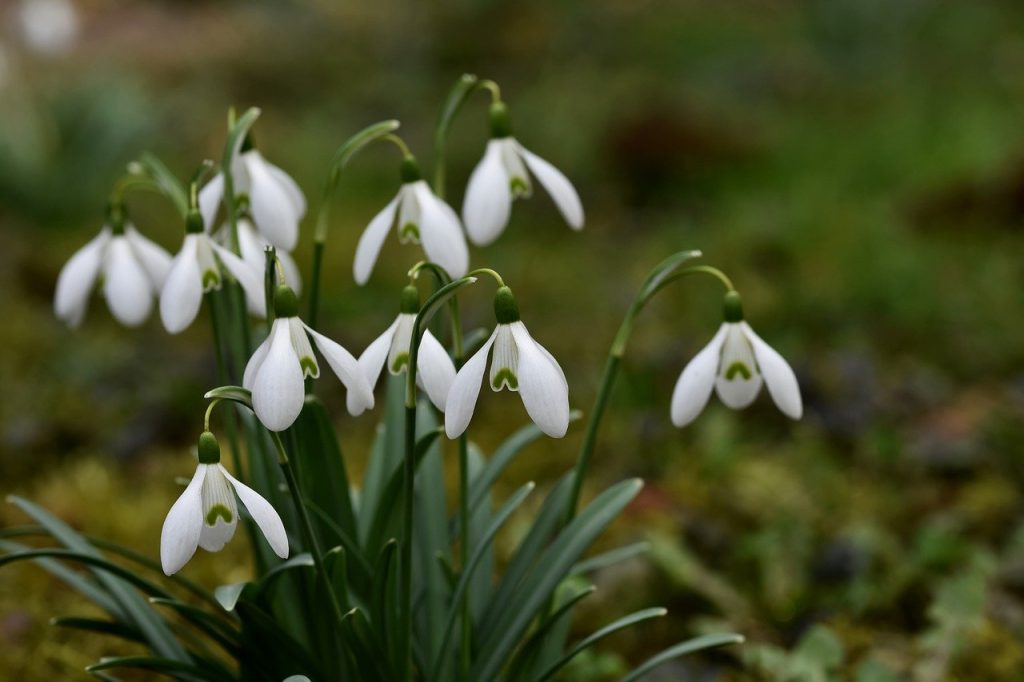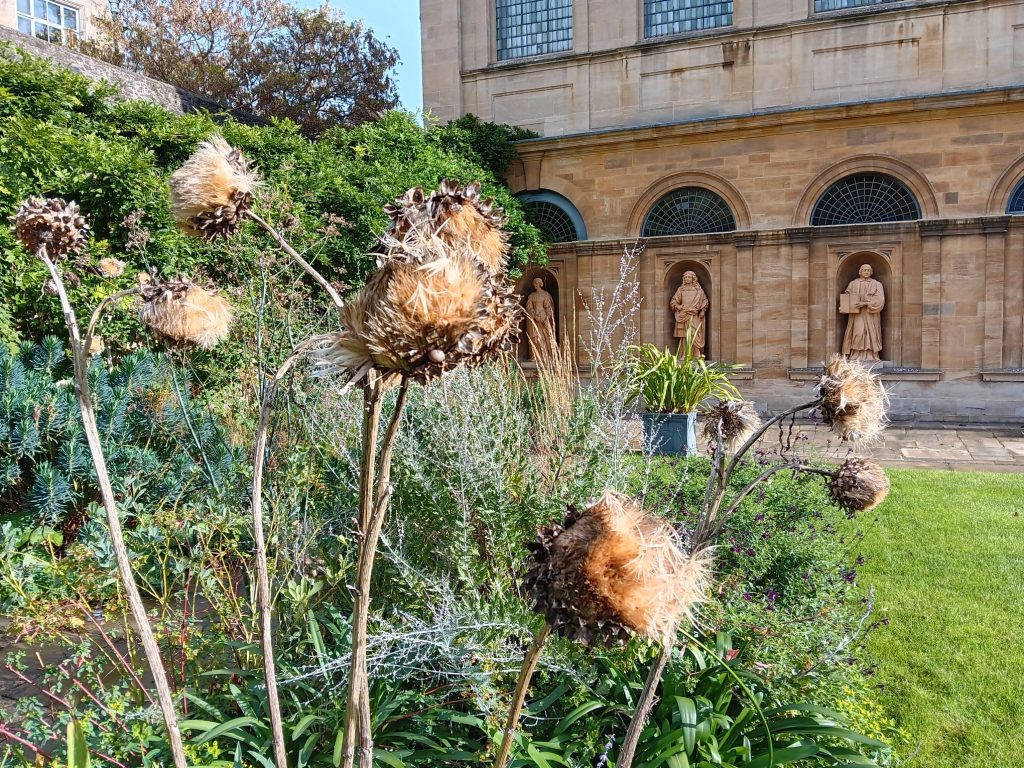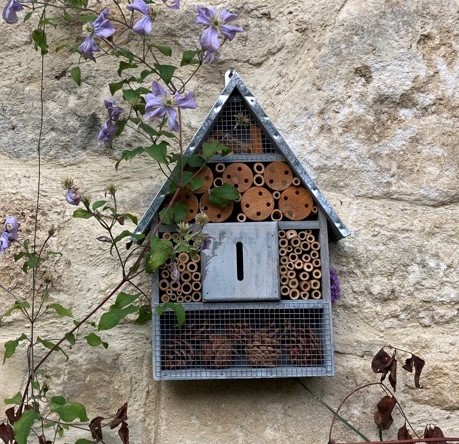Blue Belles
We are well into spring now, and it feels later in the year than it is, as some plants, like the Fuji Cherries and Magnolias, flowered a whole month earlier than they did last year, due to a mild, wet winter. And while I am writing this, in early April, I can already see blooms I’d expect emerging in early May.
One of the joys of this time of year is the wonderful sight of a bluebell wood in full flower. Blue flowers are relatively rare and blue wildflowers even more so. Luckily for the residents of Oxford there are several bluebell woods locally and I encourage you to get to one soon.
These woods are not just visually delightful, but also vitally important sanctuaries for this threatened wildflower. Around 50% of the world’s entire population of Hyacinthoides non-scripta, the native bluebell (often called English Bluebell), is found in the British Isles.
As custodians of this beautiful flower, it is our duty to look after it, and it is legally protected. There are several factors causing the decline, the first of which is habitat loss. Most bluebells are found in old woodlands and hedgerows which have been disappearing from the landscape. Seeing bluebells in a woodland or hedgerow is generally a good indication that it is ancient. Other factors include that bluebells can be easily damaged by people trampling on them when visiting the countryside, and the seeds take between five and seven years to grow to flowering size.
Another threat is posed by its cousin Hyacinthoides hispanica, (commonly referred to as the Spanish bluebell). Since Victorian times this ornamental plant has been extensively planted in British gardens. Unfortunately, it has also found its way into natural landscapes and is spreading rapidly – via vigorous garden escapes managing to spread beyond boundaries of the gardens they were planted in, and some possibly taking root after being fly tipped in garden waste. But possibly they are also being planted into woods by well-intentioned people thinking they are replenishing the natural Bluebell populations.
Spanish Bluebells (Hyacinthoides hispanica) escaped from back gardens in Rose Hill into a roadside verge by the Littlemore roundabout.
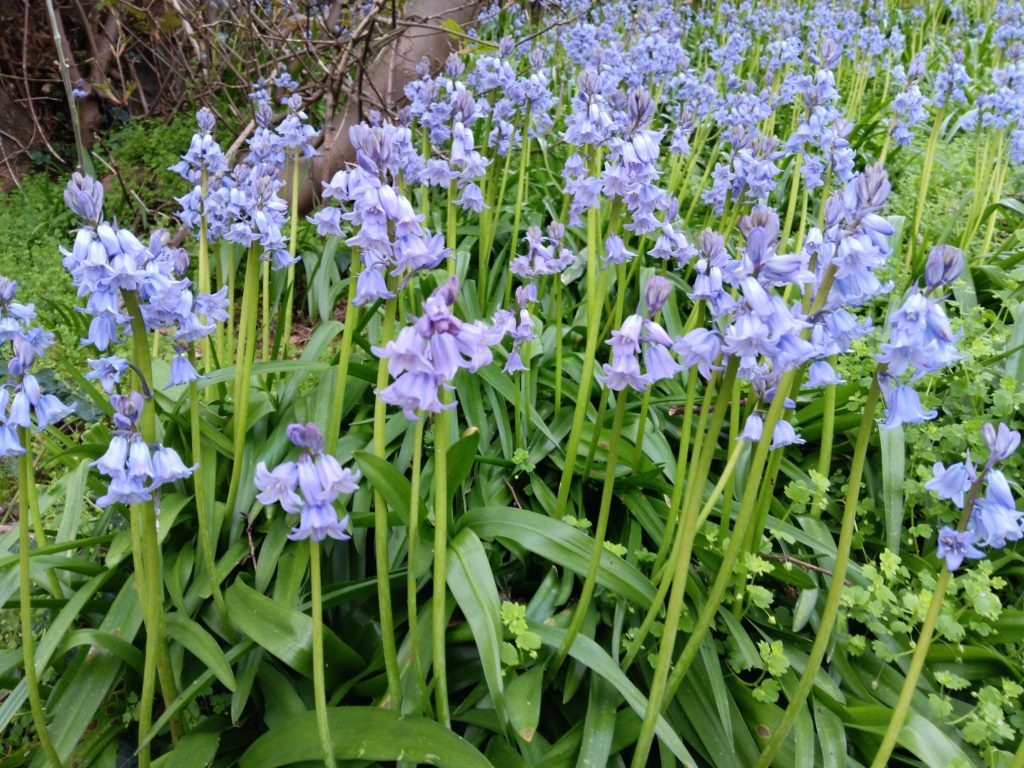
This plant will compete with the native plants, and by cross breeding with its close relative, produces the hybrid Hyacinthoides x massartiana that are much harder to tell apart from the native plant than the straight Spanish species is, so that after a while the English bluebells are replaced, without people even noticing the difference. The Spanish Bluebell has broader leaves (about 3 cm wide) and bigger, upright, flower-heads. Paler ‘Cambridge blue’ flowers are found all the way around the stem, whilst the darker ‘Oxford blue’ coloured native plants have all their gorgeously scented flowers in a row along a gently weeping flower head and tend to start flowering a touch later. The R.H.S. (Royal Horticultural Society) provide identification for their members via the RHS Gardening Advice service.
Unfortunately, all of the Bluebells I see in college and private gardens in Oxford look to me like Hyacinthoides hispanica or hybrids to me, including the ones on the main College site, and its student property at Oxley Wright. I intend to try and remove these over the next few years (it takes a while as there will be seed in ground that will grow after the plants were removed, and it is tricky not to miss a few bulbs).
You may ask why I or you should worry since they are in a garden. Well, yes, but the gardens are relatively close to wild populations of native bluebell and foraging bees fly up to 3 miles from their colony, so it’s possible for pollen from flowers in gardens to be transferred to native plants and produce seed that is hybrid.
If you know you have Hyacinthoides hispanica your garden, please consider removing it if there are wild populations close by.
However, there is no need to feel blue about losing your favourite flowers. If you can completely remove all of the invader, you can buy bulbs of native Bluebells to replace them. Please make sure that these are from a trusted company and not gathered from the wild, or miss-labelled Spanish bluebells. This is easier to do if you buy them ‘in the green’ so you can examine leaves before you plant them, or, to make sure there is no chance of mixing you can choose the following alternatives:
For those desperate to have lots of spring bulbs with blue bell shaped flowers, don’t despair: there are various Grape Hyacinths, such as Muscari armeniacum, which will quickly form a big patch. If the bulbs are fed whilst in growth you can dry them off after they go over and re-use them in pots the following year. Otherwise when the flowers finish, plant them out into a border, or naturalize in a lawn that’s not cut low in spring.
Grape Hyacinth, Muscari armeniacum ‘Esther’ is the perfect size for planting in pots for an early table top display, in a location where you can admire its delicate charm more closely.
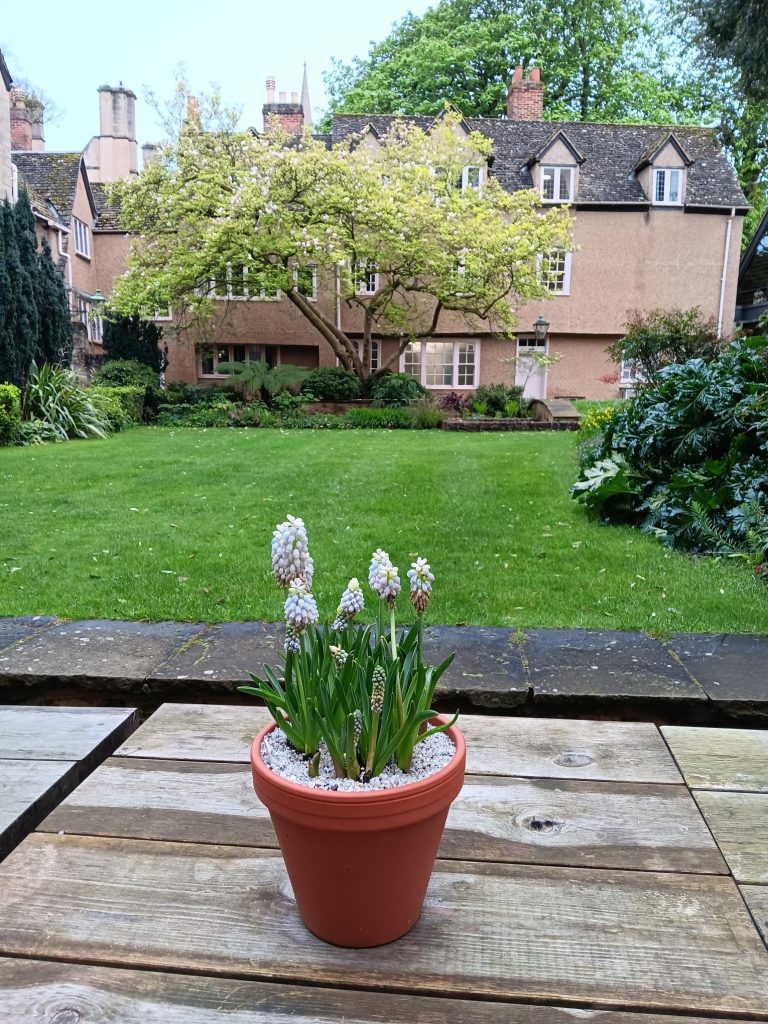
For something better behaved (Grape Hyacinths are sometimes invasive) and a bit bigger there are Bellevalia pycnantha or Scilla peruviana. Other options include Hyacinths (Hyacinthus orientalis), which come with the benefit of a delicious strong perfume, but unlike Hyacinthoides non-scripta they won’t be happy in very shady situations and will generally have smaller flowers or be ‘blind’ after the first years of flowering (if they haven’t had enough sun or fertiliser the previous year when ‘fattening’ up the bulb). Finally, for a taller, later bulb get Camassias, which can now be seen in the Fellows’ Garden.
Camassias are tall and elegant. The species ‘Quamash’ have edible bulbs that were an important part of the diet of indigenous Americans before land was settled by colonists.
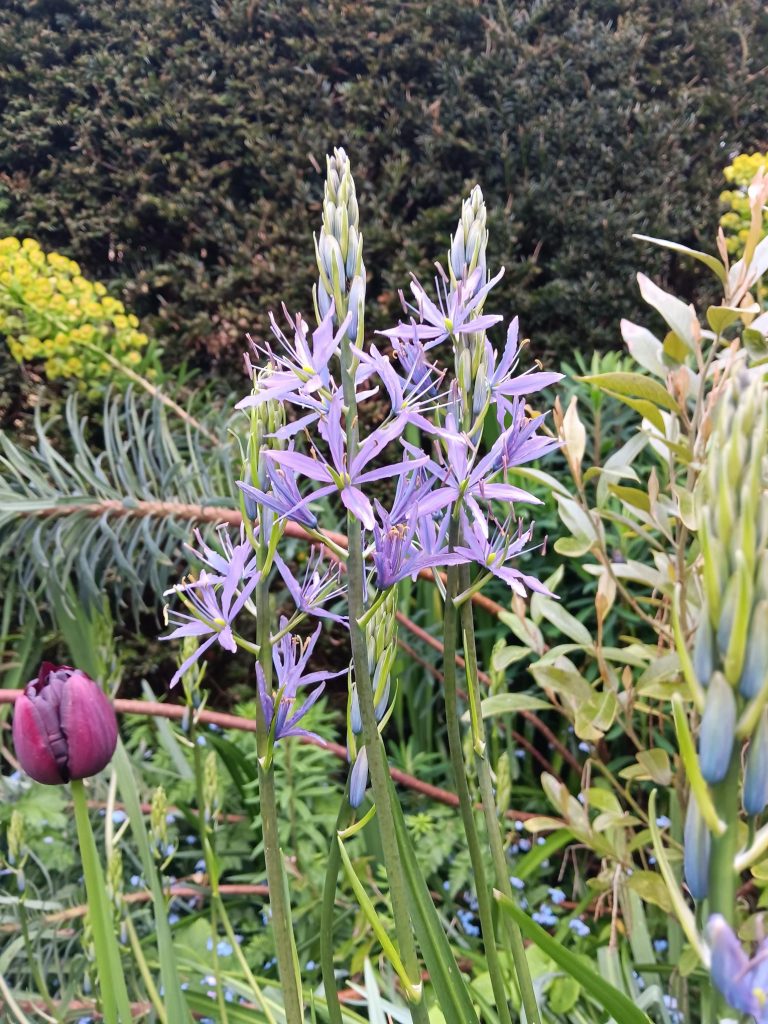
If you just want blue bell shaped flowers in your borders, and are not fussy about it being a bulb then in spring you can enjoy Pulmonaria ‘Blue Ensign’ or other Pulmonaria cultivars whose flowers fade to pink. At Queen’s we grow two types including Pulmonaria angustifolia ‘Diana Clare’ which has gloriously patterned leaves.
Pulmonaria officinalis, commonly known as Lungwort, due to the spotted leaves that caused it to be used in the treatment of diseased lungs.
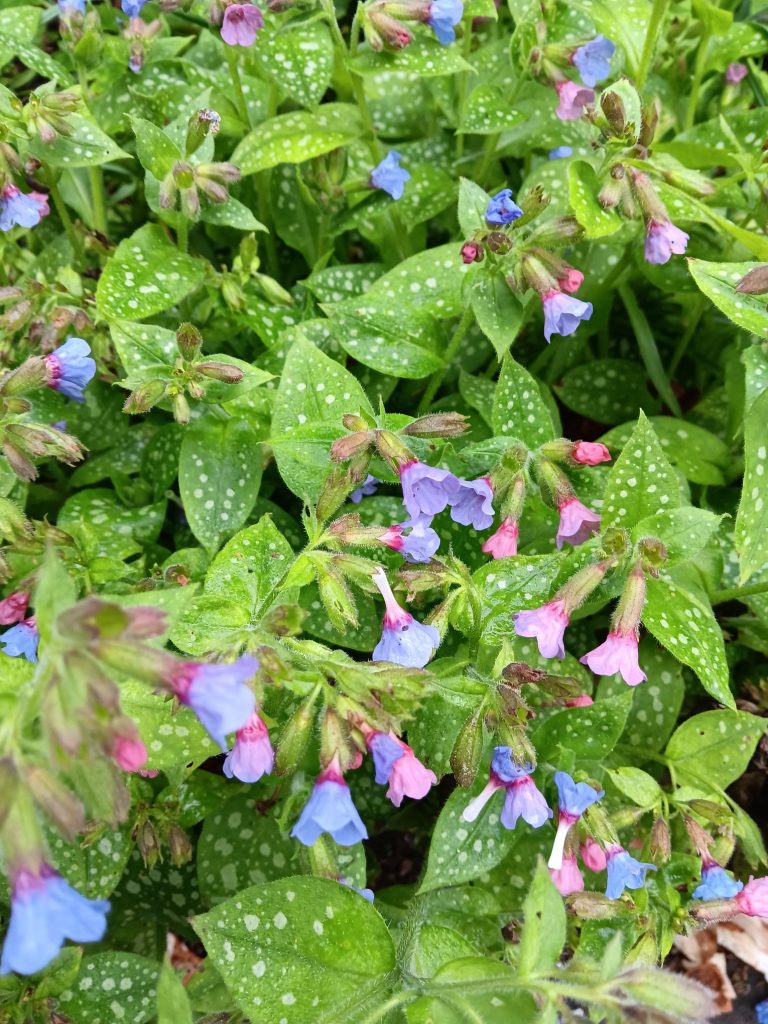
For huge carpets of paler blue try forget-me-not, like those in the Provost’s Garden. They are biennials, but happily self-seed if allowed to ‘go over’ rather than being removed as soon as they finish flowering.
Forget-me-not (Mysotis) at The Queen’s College. Ornamental cultivars make a lovely underplanting for spring bulbs, or wild forms can be grown in woodland or meadow, depending on the species.
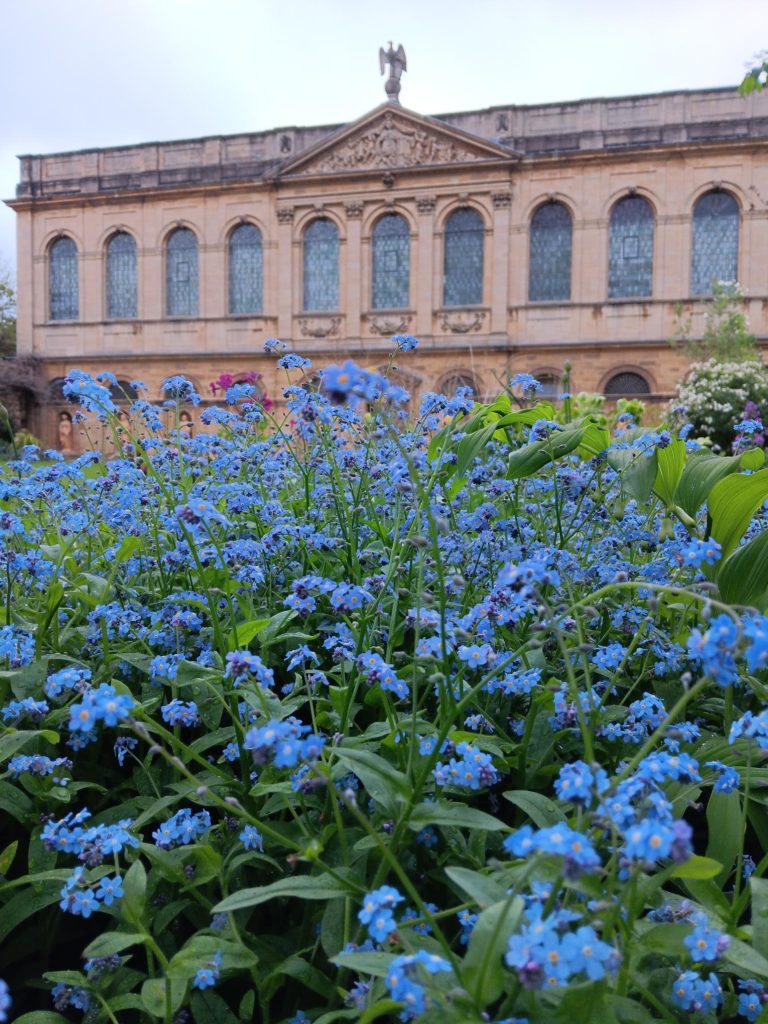
A perennial option would be Omphalodes cappadocia (which the eagle-eyed can find in the Fellows’ Garden), or for something bigger and longer flowering, you can try Brunnera macrophylla, whose cultivars often have the added interest of variegated leaves.
Omphalodes cappadocia provides intense blue blooms that catch the eye in the Fellows’ Garden, despite its diminutive size.
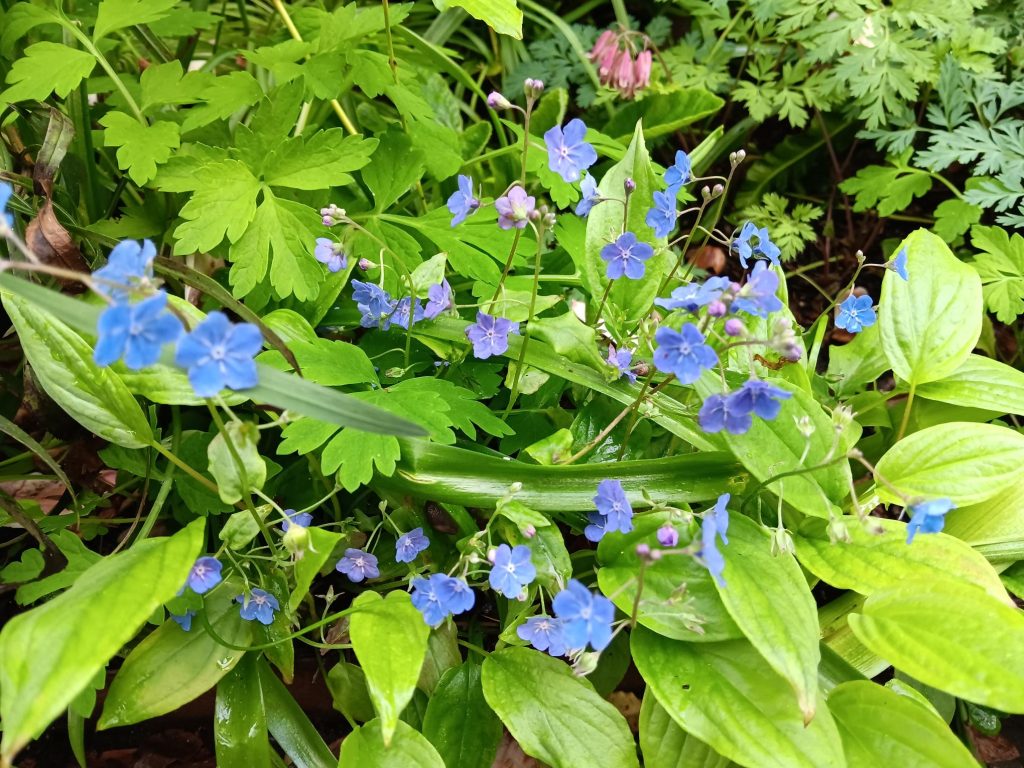
Brunnera can be found in the Fellows’ Garden and the Provost’s Garden and provides interest for much of the year due to the fabulous leaves.
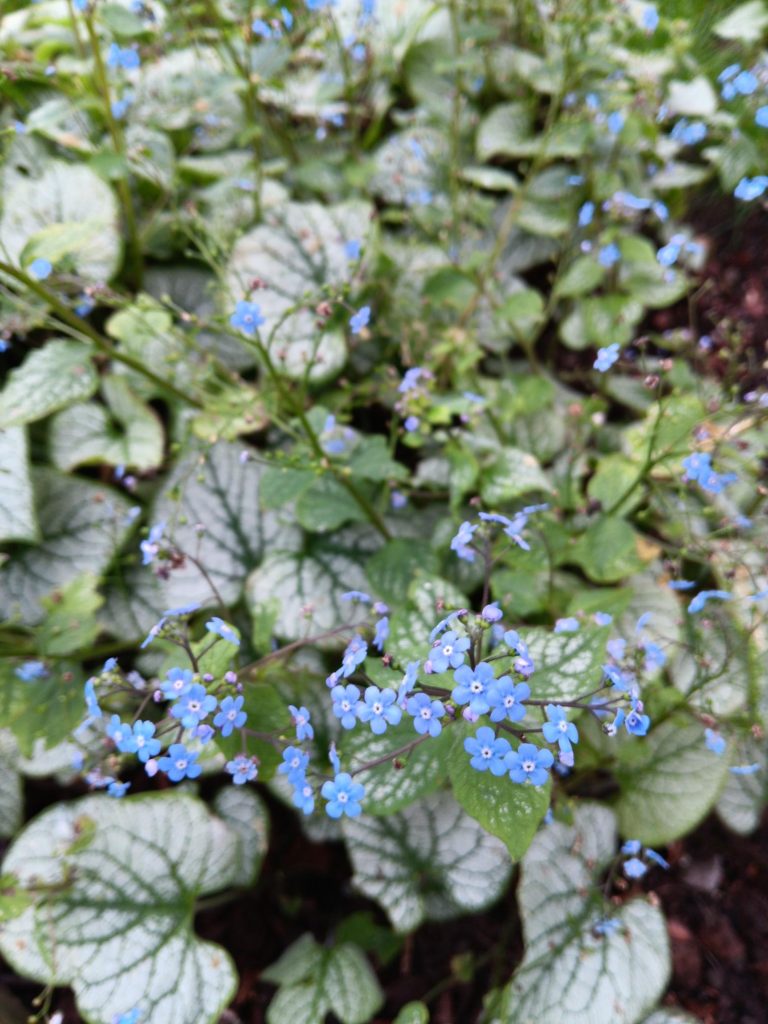
If you are content to wait a bit longer for your bolt of blue, you can enjoy those other floral blue bells, Campanula, some of which are native to the UK, and are available in a multitude of flower sizes and hights. Campanula glomerata, which has the common name of Clustered Bellflower, has a long flowering period, sometimes starting as early as May. Another long-flowering Campanula that produces masses of flower is Campanula poscharskyana, which is often seen growing on walls, or in cracks in paving. However, don’t plant it unless you are happy to have it ever after as it can be difficult to remove especially if you garden organically. If you fancy some huge bells try Campanula’Sarastro’, which I hope to plant at Queen’s. At the other end of the scale is the native harebell, Campanula rotundifolia, dangling its dainty thimbles in summer.
Should you wish to keep the theme going on into summer there are two more fantastic plants to search out: Firstly, a big shrub called Iochroma Australe, or Blue Angels Trumpet. They are considered tender, but I know of a couple that grow well in other College gardens, so I will try and get one for Queen’s.
Lastly, and more commonly grown, is Penstemons such as ‘Westminster Belle’. This plant was also considered tender, but will normally survive winters nowadays if you don’t cut off the old stems until the following spring. This has an enormously long flowering period if you deadhead, taking you through to autumn. Well, I hope that that if you are appalled by the plight of the native bluebell, and find any of the above alternatives appealing you will ring the changes and swap Spanish bluebells for different ‘Blue Belles’.
Snowdrop Season!
Well, despite being in the depths of winter still, the nights are starting to draw out again, and another sign that we are headed towards spring is the first brave little bulbs beginning to flower.
At Queen’s, the earliest bulbs are the Winter Aconite, Eranthis hyemalis, with cheerful, sunny-yellow flowers similar to a buttercup, plus snowdrops, with delicate, pendulous, white flowers. Both will, in time, form thick carpets, with the latter visually making up for a lack of its namesake (with only one, short, snow-shower so far this winter at Queen’s).
While we don’t have as many snowdrops here as they do at Worcester College, who have an impressive collection (before my time they donated some to Queen’s), we do have at least nine types of snowdrop, botanically referred to as ‘Galanthus’, from the Greek word for Milk Flower, in the College grounds. The most majestic of these is a popular cultivar called ‘Magnet’. This one is relatively easy to identify as it stands head and shoulders above the other ones that grow here.
I hope to add more to this collection over the next few years, and while most people buy and plant dry bulbs in the autumn (especially of the species Galanthus nivalis, which is the one most commonly found in gardens), there is a resurgence of people buying snowdrops ‘in the green’ when the plant is in full growth, and even in flower, but not always in a pot. Therefore, now is the perfect time to get some new plants, either by mail order or at a rare plant fair. There are several specialist nurseries and if you are surprised at there being enough plants, and enough money to be made from this humble bulb to support those businesses, then you may be interested to read that there are over 19 different species of Galanthus, and 1,000 plus cultivars, with new hybrids being continually added as people breed new ones, and the occurrence of natural crosses.
These hybrids are eagerly bought by people who have fallen deeply in love with the charm of snowdrops and call themselves Galanthophiles. They are willing to pay staggering amounts for a single bulb of new hybrids that have some unusual feature, especially those that have a yellow (normally referred to as golden) colouration where green would normally be found. So far, the most expensive snowdrop in the world is a cultivar called Galanthus plicatus (‘Golden Tears’), which was sold for £1,850 in 2022.
While I don’t have specialist knowledge of real Galanthophiles, and do not intend to spend thousands of pounds, I do have a great fondness for this plant and get excited by the vast array of different varieties, particularly those with unusual green (or yellow) patterns on inner, or even outer, petals.
For those who are happy to gaze from afar, rather than get up close and personal with their plants, there are still benefits to be had from choosing a few cultivars that are different from the diminutive Galanthus nivalis, as other species and their cultivars flower at other times, (though still when the garden is relatively barren and benefiting from snowdrops coming out). It is possible to have snowdrops from September to April, weather permitting, so if they do well in your garden and you want some more flowers in winter try some of the less common species and cultivars. I intend to get some that will flower earlier, such as cultivars of Galanthus reginae-olgae, and later than those in our current collection to extend the season.
And lastly, for those who don’t see value in these little beauties, they contain an alkaloid called galantamine, that despite being poisonous has been found to help treat dementia, so, for me, this makes snowdrops worth treasuring.
To bed! To bed?
Even though it does feel like summer has ended, so far there has been few real traces of autumn, (at least here at Queen’s). It has remained fairly mild, therefore there has still been a good number of flowers on the later flowering species, and, apart from the Fuji Cherry trees in Front Quad, most plants haven’t yet given us much in the way of seasonal colour or started dropping leaves, apart from the Beech tree in the Provost’s Garden.

While we still have good growing conditions there are a few jobs that can be done on the lawns along with the mowing. The lawns at Queen’s are sometimes scarified to remove thatch and moss, both of which curb healthy growth of turf by reducing the amount of water that reaches the soil in dry times and stopping airflow, causing fungal disease. The lawns are also occasionally aerated, either using a garden fork or a machine that punctures the surface like a slitter, helping to deter moss by combating compaction. Both of those activities can cause the turf to look quite messy for a while, until the grass regrows, which is why it’s good to do it in early autumn, to allow the grass time to recover before winter sets in. The recovery can be assisted by top dressing (normally using a sandy mix, to increase drainage) and reseeding any bare patches with grass of a similar type (don’t sow utility grass seed if you have fine turf and vice versa). There is also the option to use fertiliser, which at this time of year would be an autumn feed which strengthens the root system, improving the plant’s resilience.
However, now we will start experiencing ‘Fall’ full on, and the big tidy up will start as we ‘put the garden to bed’.
Clearing fallen leaves is a traditional autumnal task, but recently there has been a lot of discussion about if it’s necessary or desirable. Many invertebrates will overwinter in leaf-litter and provide birds with a food source in the colder months (I am sure many of you will have witnessed a blackbird searching through loose leaves for a morsel of food).
A layer of leaves will also form a natural mulch protecting the soil from erosion, providing insulation for the roots of plants and preventing the water that’s in the soil being lost too quickly by evaporation in dry and windy conditions. Plus, it helps hold back weed growth.
It may look as though there is no reason to collect leaves anymore, but of course in some cases it is still necessary for instance if the leaves fall on paths and are slippery, or on lawns where they can damage the grass by blocking out light and promoting fungal disease. In the latter instance, most leaves are quickly removed by mowing the lawn on a higher cut (don’t do this if there is a frost as walking on frozen grass will damage it, and you will be left with a track of black footprints).
It is also advisable to clear the leaves off the crowns of smaller, weaker plants if they are not tender or dormant and therefore benefiting from or unaffected by the leaves. Last winter I left quite a lot of leaves on the back of the borders (less at front where it can end up on paths and lawns) but started to clear in late winter before the bulbs came up to prevent smaller species like snowdrops being hidden.
Whatever you do, don’t get rid of leaves as it breaks down into fantastic compost.
It will take between one to three years depending on the species of plant, size of leaf, if the leaf has been shredded by a mower or garden vacuum, and whether or not it’s mixed with grass or other greenery. If you are allowed to burn garden waste, and wish to burn dry leaves, just be careful as there may be hedgehogs hibernating in piles of leaves or sticks.
The next biggest task in the garden at this time of year is cutting back, which is really pruning for herbaceous plants and an extreme extension of the deadheading done throughout the year.
Again, there has been a move away from doing this in recent years, prompted by a new garden aesthetic which appreciates the winter structure of plants, plus the rise of eco-friendly gardening.
When deciding if, what, and when to cut back I tend to ask myself these questions:
- Do I like its appearance?
This has three main factors for me. The first being has it ‘gone over’ before the surrounding plants have? If a plant has finished flowering, has uninteresting seed heads and has gone brown while it’s neighbours are still attractive, I will chop it to the base to keep the area looking fresh. And doing this in late summer with the earlier flowering plants can result in the border looking summery for another two or three months if planted with the right species and with frost free conditions. In some plants like Echinops it can even promote new growth and a second flush of flowers sometimes in mild conditions. Second, will the leaves change colour or the seedheads look nice? If the answer to this is yes, I will most likely leave it until it begins to look tatty and then chop, but in the case of grasses that look good all winter that means they will be left to March, when they need to be removed to allow the new shoots to come up. Third, will it look nice with frost or snow on it? Again, keep until the answer is no.
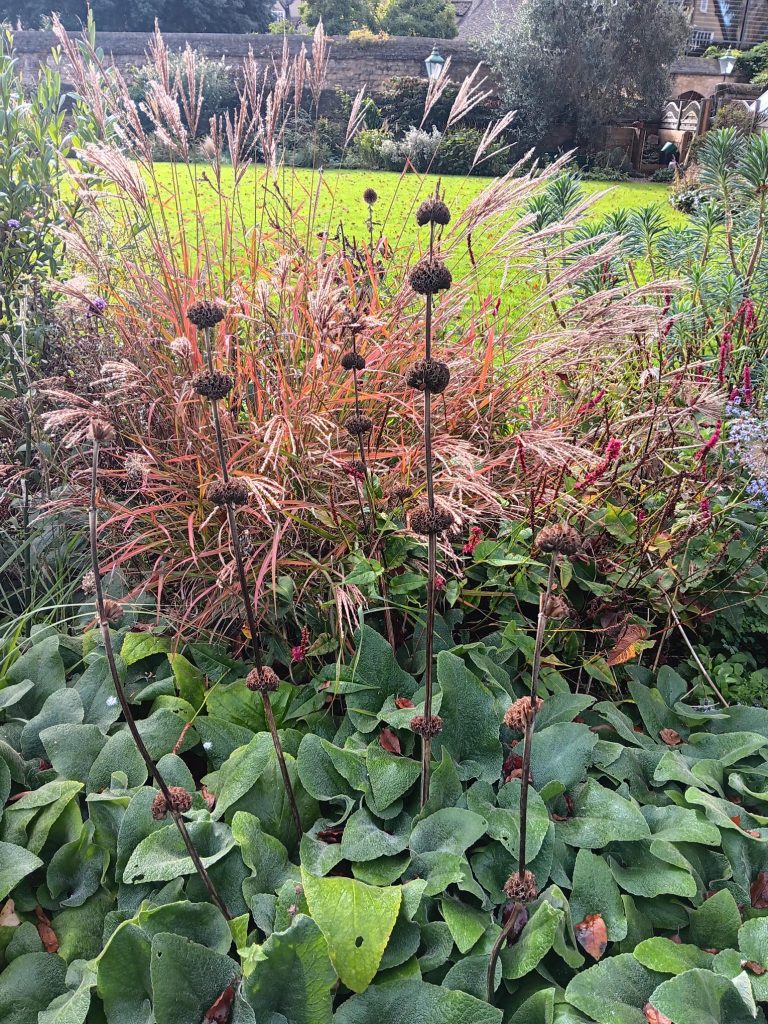
- Does this plant have wildlife value?
If the seeds haven’t dropped from the seedheads they can provide a great food source, for birds in particular, but they also can provide refuge to invertebrates, along with hollow stems i.e. those of Angelica or curled up leaves. Of course, if you don’t like the look of these plants in winter and would rather chop them down you can put out bird food and have a beetle bank or bug hotel for the creepy crawlies.
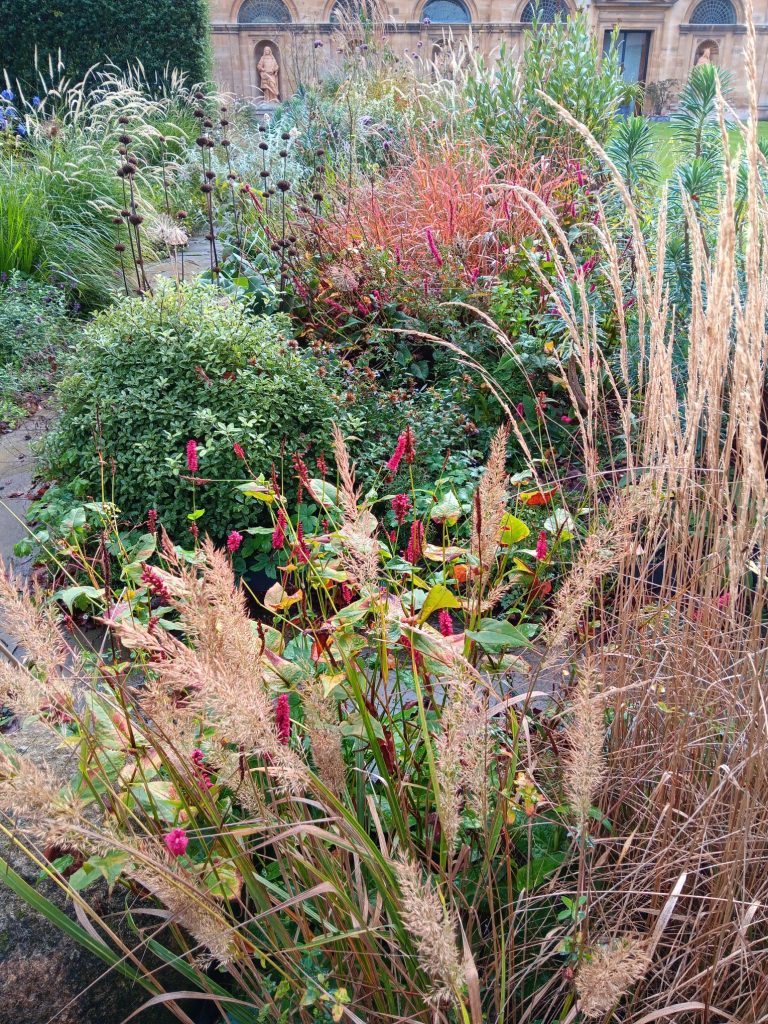
- Is it ‘practical’ to cut some or all of it down now or sensible to leave some or all of it?
I will sometimes lop something down completely or take a few stems down but leave the rest for practical reasons such as –
Time
If something will take quite a while to do, and that time is unlikely to be available later in the year or in the following year before spring, but there is time now it’s sensible to just get the job out the way.
Safety and access
Consider removing spiky/thorny plant material by paths, or anything narrow sticking out at eye level, as in poorer light conditions it’s more likely that they will cause harm. Also, plants flopping over paths, wet with rain, fog and dew can be an inconvenience to passers-by, soaking clothing, so some stems can be removed or cut partway back to give a clearer passage.
Frost protection
Some tender plants benefit from being left untouched until spring, as their stems provide protection against frost. A case in point is Penstemon, especially the larger flowered cultivars. The foliage of some plants can also protect neighbouring, less hardy plants from the elements, but be careful as it can also flop, especially once frosted or after snowfall and go from insulating blanket to rotting barrier which brings us to the last consideration.
Visibility
Will leaving the old stems and leaves of something hide winter and early spring flowering plants from view, or worse, impede their growth? If you plant for year-round interest, you will likely have to sacrifice the old to appreciate the new.
The end result is that I start cutting things in late August and don’t finish until the following March as I constantly ‘edit’ the borders.
You can put all the cut material on the compost heap, or, if you don’t have a composting area, (or you do but you wish to save time, and you’re not a neat freak) you can use the ‘chop and drop’ method as I do in my home garden, which has the same benefits (and drawbacks) as the natural mulch created by leaving fallen leaves on the borders. Whichever you choose to do, it will break down into compost faster if it is snipped into smaller pieces.
The remaining important task is to bring in the tender plants and replace the ‘summer’ bedding with ‘winter’ bedding. I brought in Pelargoniums and succulents three weeks ago, before the first air frost, just to be on the safe side. They could have safely stayed out as if turns out but, having not got spares, I didn’t wish to risk it. If you have time and space available try to take cuttings of tender plants in late summer as ‘insurance’, then you can push the boundaries and keep summer going for longer. I have replaced the planting in the urns in Back Quad but the Provost’s pots are still going strong so I have left them in place, and will not remove the tender plants until they finish flowering or there is a ground frost forecast, whereupon I will bring those into the greenhouse. I selected perennial plants, that can hopefully be reused next year and will put hardy plants, also perennial, in their place.
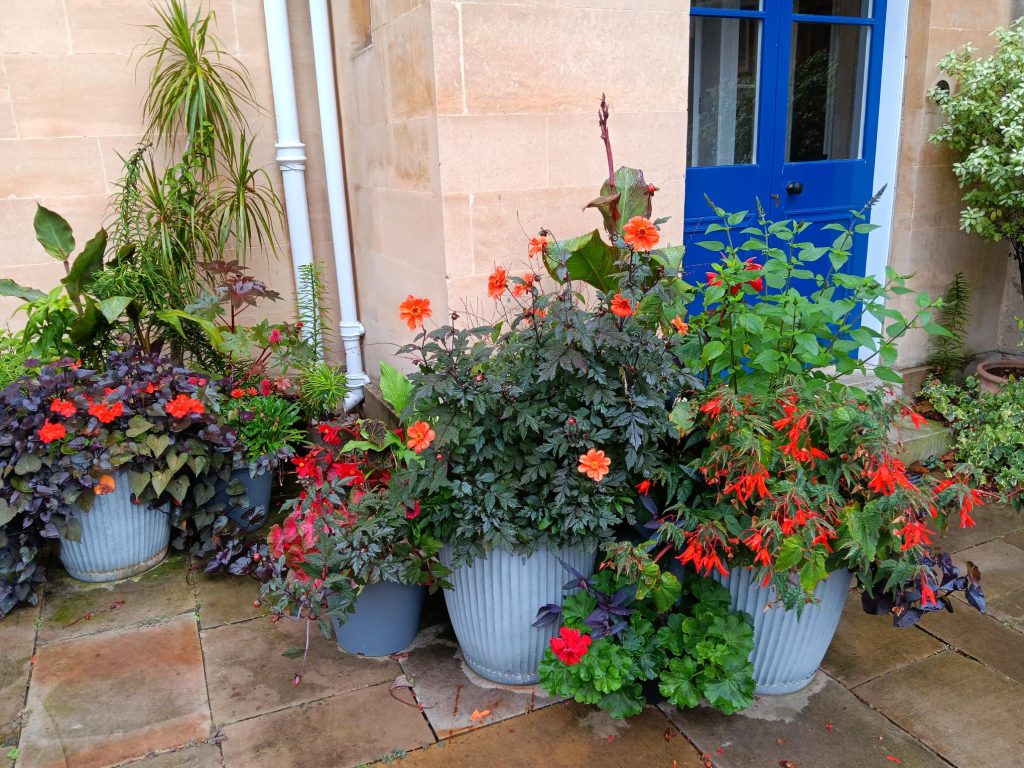
Of course, if you are bringing your tender plants into a greenhouse or conservatory, it is sensible to give it a clean and tidy beforehand as it’s easier before it’s crammed to the rafters, and may create a bit more space in the process. Cleaning the glass, if not done over the summer, will help maximise light for the plants, especially if the glasshouse is given extra insulation by attaching bubble wrap inside.
So, as the garden settles down to sleep for a few months, I shall still be busy and every now and then the garden will stir in its slumber to provide us with treats that delight all the more for their relative rarity, making me think that perhaps it’s only lightly snoozing and like us is still active throughout the colder, darker months.
It’s well worth keeping your eyes peeled so you don’t miss all the natural beauty still to come.
Wild about Gardening by Head Gardener Gwyneth Hanson
The gardens at Queen’s are one of many beautiful green spaces in Oxford. They provide members of the College community with a relaxing, natural space, a resource which is increasingly recognised as an essential aid to health and happiness. However, it’s not just humans who benefit from Oxford’s green spaces, it’s also wildlife; with urban sprawl and the destruction of wilder landscapes in the countryside, there’s less habitat for native creatures beyond the walls of College and consequently more needs to be done within College to help out native animals.
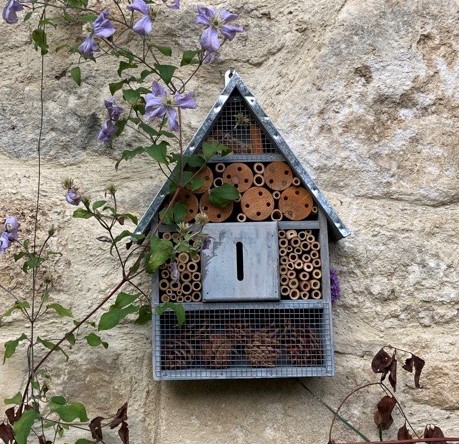
Encouraging Birds and Insects
The gardens already provide extra habitats through the addition of bird and bee boxes, which continue to give safe nesting sites. I also continued to feed the birds here from when I arrived in December until the middle of Spring.
The plight of pollinators (which include moths, hoverflies as well as iconic bees) is well known and of critical importance, so it’s worth considering their needs when designing a garden. There were already lots of pollinator-friendly plants at Queens when I arrived, and I hope to increase this over the next few years, choosing plants with single/open flowers where the nectar and pollen is easy to access, or plants that flower very early or late in the year when there are few other food sources. In the winter months the Sarcococca growing in Drawda Garden was alive with honey bees feasting on its nectar whenever the weather was warm and dry enough for foraging flights.
Water is also important for insects, so it’s good to provide a dish of water, with pebbles for landing on, especially in dry weather. I have put a wide shallow bowl in the Provost’s garden for insects and birds to use. If you have enough space in your own gardens a pond would be a perfect way to help not just them, but also small mammals like hedgehogs (just make sure it has gently sloped sides so nothing is accidentally trapped in the pond).
Other ways to help birds are to have hedges and shrubs for them to hide and roost in. If you want to trim these, you need to bear in mind that birds may have chosen to nest in them, and you are not allowed to disturb nesting birds. The RSPB say that the breeding season generally runs from March to August, so try to wait and do any heavy cutting back outside of these months, and always look carefully before starting the task.
Another great thing you can do for birds is to grow plants with fruits that birds enjoy eating. I intend to plant some more berry-producing plants, hopefully starting this autumn, in time for the cold winter days when birds most rely on extra food.
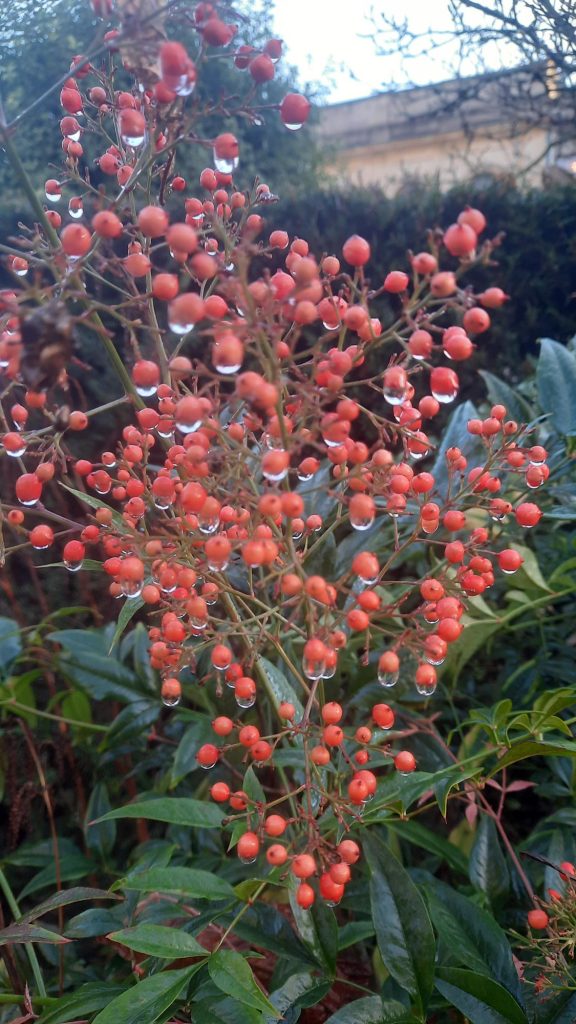
Controlling Problem Insects and Weeds
As well as providing food and shelter for wildlife, there are also plenty of other things that help by us not doing them.
I don’t use insecticides for problematic pests as they often kill more than the insect you are aiming at. Instead, I use bio-control for critical problems like box moth, which can be targeted in its caterpillar stage by a bacillus that just attacks the caterpillars alone. For slugs or vine weevil, nematode worms that feed only on them can be used.
I don’t worry about small infestations that only cause cosmetic damage, as most things are only a temporary issue and if you build up a population of birds, hedgehogs and predatory insects (like lacewing and ladybirds) in your own home gardens, then your garden ecology will deal with the pests for you.
If you get alarmed by a plague of aphids you can deal with that by squishing them or squirting diluted washing up liquid on them.
I try to avoid using harsh chemicals like Glyphosate to treat weeds, instead I physically remove them, though on hard surfaces diluted vinegar (about 20% vinegar to water) can be sprayed on. On the borders, mulch can be applied after all the cutting back has been done and before the bulbs push through to suppress weed growth.
Conserving Water
Mulch is great for keeping the weeds down and also keeps moisture in the soil, which reduces the need to water. We should be trying to reduce our mains water use but this has been tricky in recent years with our changing climate. Ideally any watering should be done early in morning or at end of the day to avoid evaporation. If you are desperate to water your lawn try switching the sprinkler on at night when there will be less wastage. If you don’t want to pad out in your slippers, get an automatic timer (which also saves you having to ask someone to pop round when you go on holiday). There are seep hoses for laying in borders, which can be used with a timer, and are much more efficient if run at night rather than watering borders in the daytime. But really try and avoid mains water if you can.
Invest in water butts if you have space (the bigger the better) and then only water those plants that are critical. This chore can be reduced by choosing plants that are drought tolerant.
Many of the plants growing at Queen’s are drought tolerant, especially plants in the Provost’s garden, which being situated on top of the Lower Library, has a very shallow soil depth (mostly 30 to 40cm) and is also planted in an extremely free-draining growing medium with little actual soil. Plants that cope best with dry conditions not surprisingly come from more hot and arid parts of the world. Plants that do well in the dry conditions at Queen’s are generally from the Mediterranean climate regions and within the sheltered urban microclimate, are normally hardy enough to get through mild winters. They may struggle at higher latitudes or altitudes especially if there is no shelter from wind, frost pockets or heavy soil that doesn’t drain and sits wet.
You can try looking in your neighbours’ gardens for plants that are adapted to dry conditions (plants with silver, needle-like or hairy leaves or those that are deep rooted) to see what may be resilient in your garden, which will have similar climate and soil. You can keep your garden looking good with minimal input, though do remember plants need access to some water to have a decent nectar flow for pollinators.
I hope you have a great summer sharing your garden with the animals who call it home and I will continue encouraging more to join me here at Queen’s.
Seeds of Change by Head Gardener Gwyneth Hanson
Although we are entering the summer term, headed towards the end of the academic year, it’s currently still spring, a time of beginnings.
For me personally, it’s the beginning of my first full year as Head Gardener at The Queen’s College, having started in December and never seen the garden at this time of year before. And in horticultural terms, spring it is when the garden awakes from its winter sleep and begins growing again.
I also think of spring as an optimistic time of year. I think we all look forward to the sunnier days ahead, and being out in the garden allows you to see the changing seasons, enjoy the sunshine and fresh air, and, of course, get some exercise. It is not surprising that gardening is now being prescribed to help people with various medical conditions as it is so good for us, and, if you garden organically, totally chemical free.
The most optimistic and feel-good gardening task, in my opinion, is seed-sowing. You can sow seed all year round if you wish, and, in fact, some seed is best sown in late summer and autumn, when it is fresh and would naturally land on the ground, especially if it requires a cold period before germination. However, most people sow most seed in spring.
I have been engaged in this activity at College, sowing a wide range of plants, from dramatic caster oil plants Ricinus Communis ‘Impala’ (a tender plant that grows quickly into a tall plant with fantastic tropical-looking dark foliage, great for exotic bedding, or just as an architectural gap-filler or backdrop to other plants) to perennials like a species of Lavender called Multifida that has the usual elegant, scented flowers that pollinators adore, but with unusual shaped leaves and it is quick growing compared to other lavender cultivars.
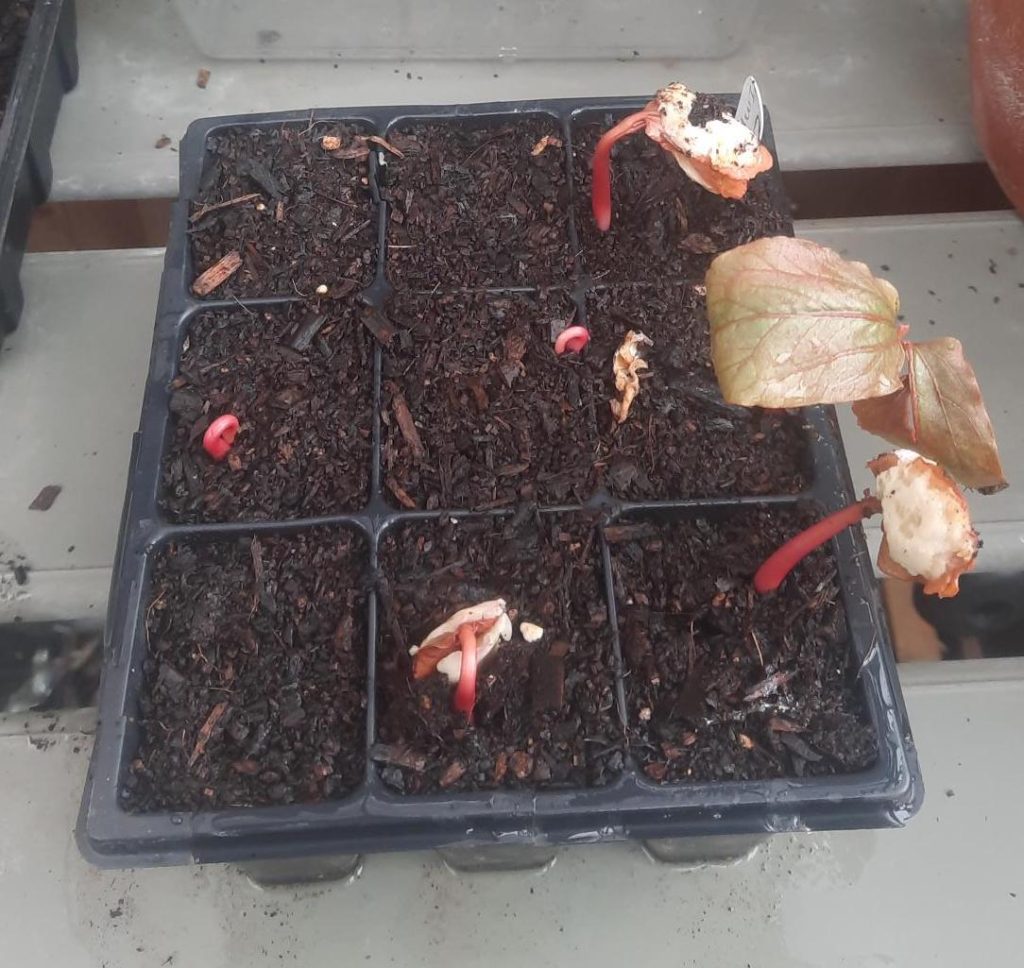
You may wonder why spend the time growing from seed rather than simply buying plants? Well, along with the great satisfaction gained from germinating seed, there are other advantages that make it well worth doing.
Firstly, some things are very difficult to find available to buy as ‘ready grown’ plants, so, by buying seed, you open up a wider range of things you can grow, especially since if the plants are available as ready grown items, they will be much more expensive. A seed packet is very rarely more than £5 and unless you purchase something that’s an F1 cultivar*, or is exceedingly rare, or produces very few seeds, you are likely to get at least 25+ seeds; many popular seeds will have 100 or more seeds in each packet. Contrast that with it being increasingly hard to find an individual plant for sale for less than £5. And those that are, are generally in one litre pots or smaller. There is the option of buying multipacks of module sown seedlings or plugs plants, but they are more fragile than garden-ready plants and need growing on. They are also still normally at least twice the cost of seed for fewer plants, so, unless it’s tricky to germinate, you may as well sow your own!
Another appealing factor is that you can control all aspects of the growing, like using peat-free compost, something that isn’t yet done by all commercial growers, and avoiding the use of chemicals, especially on plants you’re intending to eat. Also, you can grow the plants ‘hard’ exposing them to more cold or less water than the plants raised in commercial glasshouses, which are given optimum conditions for fast growth. Nurseries benefit from a quick turnover as they would rather sell a six-week old plant that’s had less inputs and get another crop on the way than make the plant hardy. If you grow your own, you can produce a tougher, more resilient plant with a good root system, that should be better equipped to survive when planted outside. And, depending on the plant, you can also sow things directly, in situ. This is normally only done with annuals and biennials i.e. flowers like Nigella (love-in-a-mist), salad crops like rocket and other annual vegetables (for instance dwarf French beans), plus wildflowers, particularly native arable ‘weeds’ such as field poppies.
This requires making a good ‘seedbed’, which traditionally would have involved weeding and digging over the area you’d selected and then raking and firming the soil until it was level and had a consistency like fine breadcrumbs (referred to as a ‘good tilth’). However, many folk are now choosing no-dig gardening and it can be tricky to make a seedbed if your soil is heavy clay and the weather remains wet, and once sown, the seed is subject to not only poor weather conditions, but pests like slugs and mice plus fungal disease at its most vulnerable stage of growth. Therefore, it’s often advisable to start seeds indoors in sterile compost, and then prick out (move seedlings with ‘true’ leaves rather than initial seed leaves into individual pots or cells), before planting out (the main exception to the rule being root crops as they don’t appreciate root disturbance). However, it’s often convenient to grow carrots etc. in pots of stone-free compost, and if you have the space, you can sow many in a large container (or herbs like basil) and keep them safe inside until they’re growing nicely.
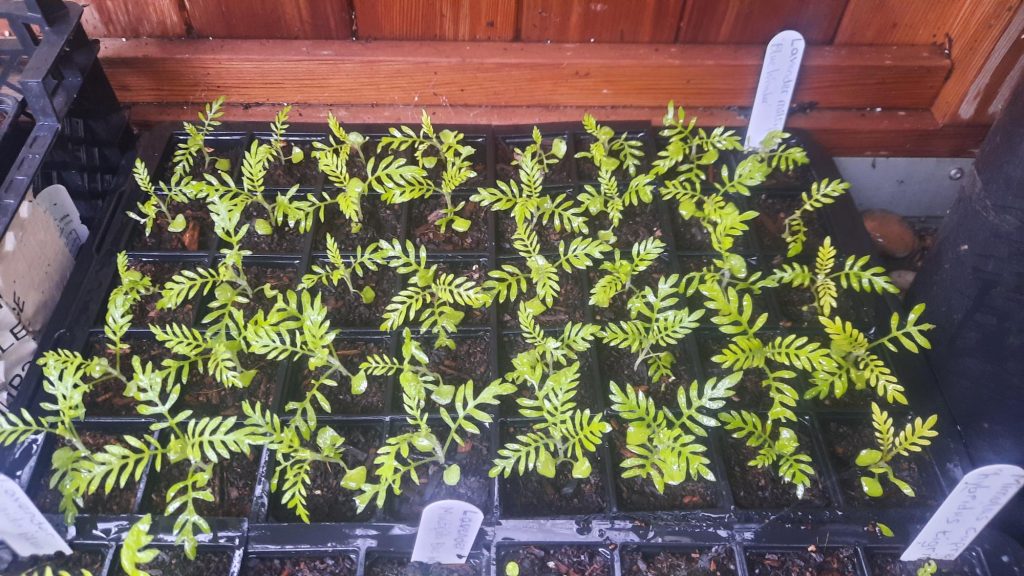
There is still time to grow many favourite ornamental and edible plants to enjoy later this year from seeds. So, if you like having plants in or around your home and have a windowsill you can fit a seed tray on, why not begin your own gardening journey this spring and grow something you fancy and look forward to reaping the rewards? I know I’m looking forward to growing on and planting out the seeds I’ve sown at College and sharing the result with you all.
*An F1 cultivar is expensive because it is the result of breeding two different strains of a variety to produce a third variety. The term ‘F1’ stands for Filial 1 or ‘first children’.

